IMDb metadata is 1 hour and 22 minutes, rated 5.1 from 1701 cinemitizens.
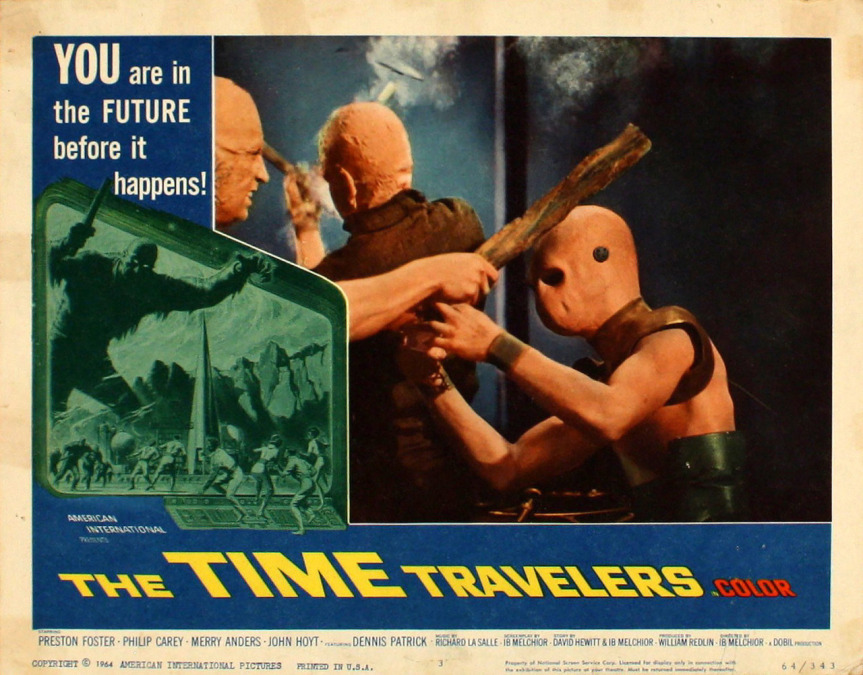
Verdict: They left home with the AMEX card!
In 1964 three whitebread scientists are reading dials and shouting for more or less power. They cannot seem to make up their minds. Are they wearing the white-coats to keep time dust off their clothes? Meanwhile: Levers are levered. Switches are switched. Dials are dialed. And then …
It is the year 2071!
The Earth is a wasteland! The Republican ascendancy must have had its way. The advance of human knowledge has stopped.
The three scientists and comic relief step through the time portal which promptly collapses behind them stranding the travellers without visas. They are set upon by vestigial Trumpettes, crippled and deformed, i.e., unchanged: slavering, hunched, overweight, waddling… Yikes.
In one notable early scene two of these savage Trumpettes attack the lady scientist, who thinks fast and sprays them with a fire extinguisher and that drives them off. Hooray! She does not scream, faint, go pale, or make coffee, but does some quick lateral thinking and takes decisive action. How rare is that for a woman in a creature feature in 1964? Very. Moreover, at no time does anyone talk about the contradiction of a women being a scientist. Take a bow, scriptwriter!
The illegal immigrant time travelers without visas take refuge in a cave where they find the few remaining Mole Hillaries underground. The Moles confirm the Republican armageddon which sent Evangelicals and most everyone else to their rewards. The few survivors are the Moloch Trumpettes on the surface and Eloi Hillaries underground, thus reversing H.G. Wells.
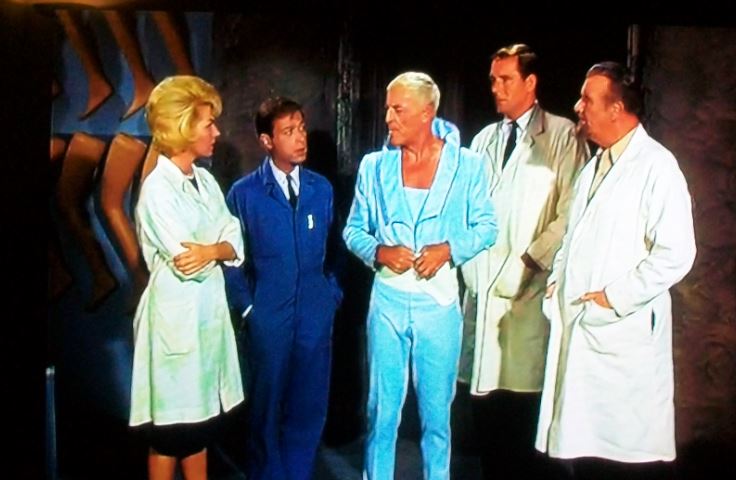 John Hoyt in the powder-blue regalia is a fine actor totally wasted in this role as the visa denier.
John Hoyt in the powder-blue regalia is a fine actor totally wasted in this role as the visa denier.
The Mole Hillaries plan to relocate to Alpha Centura where a Democratic majority is assured! They are hard at work on a spaceship and welcome additional white-coated scientific help. Meanwhile, they depend on Androids to defend them from the Trumpettes. So far all of this has been pretty snappy.
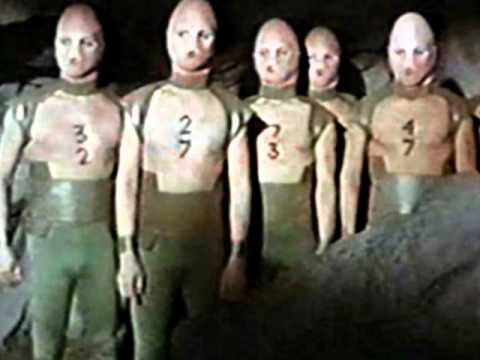 But now we hear much about the Androids, but when you have seen one droid, you have seen them all.
But now we hear much about the Androids, but when you have seen one droid, you have seen them all.
The story bogs down to an arthritic snail’s pace with expositions of spaceflight, Alpha Centura, 3D printing, and the androids supplemented with comic irritation. Tedious with a capital ‘T’ and it goes on and on. The fraternity brothers got their Zs in Act II.
These four newcomers irritate some of the Hillaries. Jealously, ambition, KPIs rear their ugly heads. With a little spreadsheet magic one sore-headed Hillary proves she won the election, no, whoops, he proves that the four strangers cannot fit onto the Alpha Centura rocket and will to stay behind and play with the Molochs. Nice, not. Help us build the rocket, yes; ride in it, no. Sounds like a familiar management move. ‘You do the work and I take the credit’ is a chapter in the McKinsey Managers Manual.
Then in the middle of another exposition, the Trumpette Molochs attack! What a relief! Much running around. Sirens sound. Lights flash. The fraternity brothers gained consciousness.
The intruder is neither a registered Republican nor a Democrat, but a human being! There is an argument about exterminating him. The lady scientist gets all compassionate and saves him. Big deal! We never see or hear of him again. He fell through a typo in the screenplay. ‘Did he get on the rocket, or not,’ asked the fraternity brothers? Good question.
Though engaged in a race against time to get to Alpha Centura (before it closes), and in a war to the death with the Trumpette Molochs, the Hillaries take time out for sunlamp bathing, arm wrestllng, and trysts in the cavelight. We see semi-clad women lounging around a spa talking about the population explosion that will follow resettlement on New Earth around Alpha Centura. Get it! The fraternity brothers sniggered.
Then the Trumpettes attack in force and in the confusion the time travelers return to 1964 to vote against Barry Goldwater. However once there they find themselves motionless. Comic irritation does his stuff. This paradox is an interesting twist. Back-up: Denied seats on the rocket, they used their iPhones to telephone back to 1964.
However, they cannot reintegrate into 1964 because the IOS updates are inconsistent. What is to become of them? [‘Who cares,’ asked the fraternity brothers?] But the Eloi have a change of heart and somehow, ex cathedra screenplay, manage to get to 1964 to offer them a place on the rocket after all. A happy ending is thus assured. Who they threw off to make room is left unsaid. Pretty sure that unregistered human being did not make it.
The story is incoherent. Though there are many incidents, the whole is less than the sum of its parts. The denouement is not the result of anything that preceded it. It just happens. Kind of like life.
The writer and director Ib Melchoir other achievement was ‘Reptilicus’ (1961). Enuf said.
Author: Michael W Jackson
‘Cave Women on Mars’ (2008)
IMDb metadata is 1 hour and 13 minutes, 5.8 from 77 cast members’ relatives.
Verdict: Spelunkers will be disappointed, as will Martians.
In the far distant future of 1987 humanity has achieved space flight and the first Mars lander is en route with a two-dork crew.
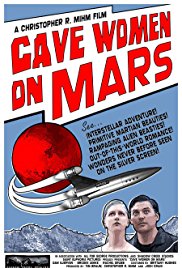
They land on uninhabited Mars to find….inhabitants. But does that matter? A little terra nullius and hey presto, no problem.
Because of the low budget, they find an Earth atmosphere and trudge around in coveralls. One of them wanders off and is…
There are women. ‘These two losers had to go to Mars to get a date,’ hooted the fraternity brothers!
One of them encounters two warring tribes of women, each of which tries to kill him, or enslave him, or otherwise have their wicked ways with him. But no, they decide he is too dangerous to live and if he dies there is no movie. What a conundrum!
Males are weak, cowardly, and enslaved by women. Realistic anyway. ‘She’ (1935) Who Must be Obeyed took refuge on Mars, it seems. (‘She’ has been re-made many times but the first is far and away the best.)
Those coveralls drive the Martian caveless women wild! The kiss is unknown to these women and …. [censored]. Knowledge!
It is filmed in black-and-white and offers a tribute to 1950s B Sy Fy movies. It is modest and the actors say all their lines slowly and clearly (because there was no budget for re-takes). In most scenes there is one camera set up and the actors do not move once the focus has been pulled.
Even so it is mildly diverting, but has nothing to do with Mars or with caves. It is a trope in 1950s Sy Fy that there are worlds of women without (real — Republicans don’t count) men, e.g., ‘Cat-Women of The Moon’ (1953), ‘Fire Maidens from Outer Space’ (1956), ‘World Without End’ (1956, or ‘Queen Of Outer Space’ (1958) to name but the a few of the fraternity brothers’ favourites.
‘Seddok, l’erede di Satana’ (1960) aka ‘Atomic Age Vampire’
IMDb metadata is runtime 1 hour and 47 minutes of Dali time, rated 3.7 by 1231 cinemitizens. Released its native Italy on 19 August 1960.
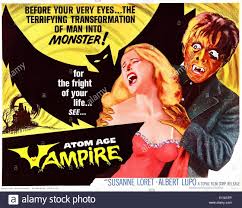
Verdict: Beau, beast, and Beauty with radium.
Jilted by her impossibly handsome boyfriend, a woman driver goes off a cliff and is disfigured. While she is disconsolate at the loss of Beau and beauty, Igora offers her the chance to regain the latter at the hands of an Emeritus Prof Mad Scientist. Igora is his loyal assistant. Her brother Igor is otherwise engaged.
Beauty undergoes the treatment which is experimental and at some point the dialogue refers to radium and Derma 28 (Dermas 1 to 27 were losers). After far too long, it works. The horse-faced beauty no longer has a chocolate sundae melted onto the left side of her face. She can ditch the Veronica Lake peek-a-boo look.
 Belle pining for Beau.
Belle pining for Beau.
But the affliction recurs, and the only solution is for the Mad Scientist….to murder young women to get their…gland bags. Prof is besotted by Beauty and he throttles even the loyal Igora for her…glands. The gland injections seem to only last a scene, and he is out there murdering ever more young women who conveniently stand around in secluded spots waiting for his attacks.
His cereal, serial, or is that surreal, killing is eased because he turns himself into a wereprof to do it. (If only.) Since there is no plot explanation for this capacity, the fraternity brothers concluded that a visiting Lon Chaney left a wolf suit behind. Following so far?
When he returns to the lab he transforms wereprof back into menacing Mad Scientist by stepping into a man-sized clear bell jar which fills with dry ice fog and out comes one lightly chilled mad scientist. So much for Clark Kent.
At times it seems his lust for Beauty turns him into Lon Chaney without the pathos, and other times it takes a shot of radium (under a full moon). But he has done for her what no other man has or can do. He has recovered her looks, killed for her, and turned himself into a monster to so. It is trifecta! He has also scuttled his career as a serious actor by playing this role.
He goes on murdering. Beauty is restive and pines for her impossibly handsome boyfriend and keeps Mad Scientist at bay. After an hour she notices Igora is no longer around. Not too wealthy with the smarts is this one.
As the body count rises, plod finally stirs and, of course, seeks advice from Mad Scientist. Handsome tags along with Plod though why he jilted her in the first place is never revealed nor what has kindled his interest in any of this. Beauty could run to Handsome, says the Mad Scientist, but then the treatments would stop and the chocolate sundae would return and Handsome would then again reject her anyway. Is this a Faustian bargain or what? Or is it an impossible mish-mash of exploitation films. Decide!
In the end, Handsome slugs it out with Mad Scientist and wins, and it turns out the last involuntary gland transplant cured her, and she no longer worries about the victims who sustained her so she can live happily ever after. A moral tale for our times.
George Zucco was made for just roles but he usually had better material. Admittedly this mad and bad emeritus professor is pretty creepy, the more so when he is trying to be suave and considerate.
The Italian title translates as ‘Seddok, the heir of Satan.’ OK, but no one called Seddok is listed in the credits. The English dubbing and dialogue were overlaid on the Italian original for the Yankee market and the title changed to capitalise on the topical interest in all things atomic. Hence the extraneous references to radium in the dubbed dialogue. Any relationship of the original Italian title to the story has been lost in translation.
‘White Zombie’ (1932)
IMDb meta-data is 1 hour and 9 minutes of run time, rated 6.9 by 7686 cinemitizens.
Verdict: Generally credited as the first zombie film. Certainly credited with cementing Bela Lugosi’e eyebrows into cinema history.

Beau and Belle have a shipboard romance on the way to, of all places, Haiti. Also interested in Belle is the travelling Planter who offers them the hospitality of his stage-set mansion for their nuptials, all the while trying to woo Belle away from Beau.
Indeed even as a surrogate father leading her down the aisle to Beau at the altar, he is whispering endearments, blandishments, and offers into her ear with the subtlety of the Twit in Chief. Fearing his charms to be insufficient, he had earlier taken the precaution of visiting Bela who agrees to render her a zombie if only Planter will prick her figure with a needle he supplies.
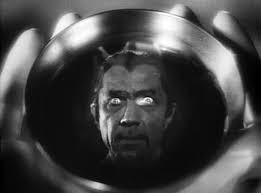 Those eyes!
Those eyes!
Rejected, Planter presents her with a rose, disguising the needle as thorn. Ouch. She dies on the altar. She is buried and resurrected for his use later. The veil is drawn.
However, she is a dead soul, a role this actor was born to play.
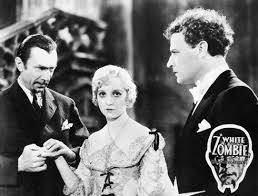
The look is as creepy as a Republican congressman from Alabama.
Frustrated Planter wants Bela to return her to normal, even if it means losing her to Beau, who is drowning his sorrows. Too late. Bela likes the Newtown dead soul look and wants her for himself.
Planter and Beau join forces to subdue Bela (‘As if,’ snickered the fraternity brothers) and by the miracle of scriptwriting they do. Planter croaks. Belle snaps out of it. Beau gets what he wants. The End.
There is much zombie lore. One early graphic scene in Bela’s sugar mill staffed by the zombies is a vision of labour that McKinsey managers call ideal. It is a powerful image worthy of Dante. Sorry to say I could not find any still photographs on the web that show it well. But the whole film is on You Tube. Go for it!
Robert Hughes, ‘Barcelona’ (2011)
A self-indulgent memoir of time spent in Barcelona by the man with shag carpet for a typewriter, the rich, soft, deep pile of his prose remains but in this instance it is largely devoid of substance. Well, unless a reader must know where Hughes drank sangria in 1983. For that information, this is the book.

Ostensibly a guide to the city, it a scrap book to selective memory mainly confined to his personal experiences. However, to his credit, and unlike some, he does note in passing the deep and murderous divisions among Spaniards. Their many failed attempts to find a modus vivendi and Hughes labours under no illusions about the future.
But all in all, it is a very short and lazy book that seems to have been spoken into a recorder and then typed. Even the final chapters on Antoni Gaudi’s architecture, though showing signs of research done long ago, seem trip with neither destination nor arrival.
 Robert Hughes
Robert Hughes
To sum up, it reads like the Fatigue of the Exhausted.
I chose it prior to a trip to Spain and to Barcelona but found it offered little of interest. He also has another, larger, book called ‘Barcelona’ (1993) to confuse readers.
‘The Portugal Sapphire’ (2013) by J. A. Jernay
Meta-data from GoodReads is 3.13/5 from 114 litizens.
Verdict: First in a series and last for me.
In these pages our heroine

– Learns conversational Portuguese in ten days
– Has hormone attacks at the appearance of any man with hair and teeth
– Starts with USD 2000 and all expenses paid and yet is broke on every page thereafter
– Trusts known criminals
– Is too naive to have made it to 29 years of age
– Flies from SFO to Lisbon in 3 hours
– Repeats the same dialogue far too often
– Cracks a long established Lisbon crime syndicate in one afternoon
– Out muscles experienced villains
– Whose legendary knowledge of gemmology is never revealed or relevant
– Who talks her way past alert criminals
– Leaves her handbag in the villains lair and has to go back for it
– Passes off an offsider as blind on a guided tour
– Does IKEA in each room
– Does Vogue with the dress of each woman and GQ for most men
– Almost none of the detail that plumps out the pages adds to plot or character
– Characters who are emphasised disappear like the police sergeant who did not collect
And so on.
Rom-krimi or Krimi-Rom is this genre bender. One in a series of many titles. First and last for me.
I came across it looking for novels set in Portugal before travelling there. No more for this reader. Though it is claimed to be a best seller in a heavily qualified attribution, among self published mysteries on Tuesday.
The prose is fluent and confident but absent either plot or character. There is some travelogue in Portugal but it is obscured by the features listed above.
‘The Time Machine’
In this case the reference is to the stage play by Frank Gauntlett performed at the NIDA playhouse in Kensington, NSW. It is a one-man show with Mark Lee, directed by Gareth Boylan. The season is 11 April to 2 May 2018.
In short, we liked it.
The adaptation of H. G. Wells’s novel is coherent and well written. The set design stimulates the imagination but is understated. Much is accomplished with lighting and sound. Though most of all there is the performance that carries the day.
Our traveller starts out a smug, erudite, confident Victorian know-it-all and ends a broken man. In between he knows wonder, fear, love, remorse, terror, and regret.
The Year 802,791 A.D. shows the devolution of human kind with the layabout fruit-eating Eloi and the dark meat-eating Molochs. In Wells’s heavy hands this situation is the division between capital and labor carried to its logical conclusion.
Though quite how cannibalism fits into that equation is never made clear, nor how it is that the Eloi benefit from the labor of the Molochs.
That Eden might rest on slave labour is a recurrent theme in literature. There is a striking passage about this symbiotic relationship in Thomas Mann’s ‘The Magic Mountain’ (1924) where the mutual dependence is made very clear without the didacticism of Wells.
It takes just over one hour, and was worth the bus ride virtually door-to-door on the 370.
‘The Mole People’ (1956)
IMDb meta-data is 1 hour and 17 minutes of run time and rated 4.8 by 2400 cinemitizens.
It is a creature feature with some differences that surprised the fraternity brothers. See the list below.
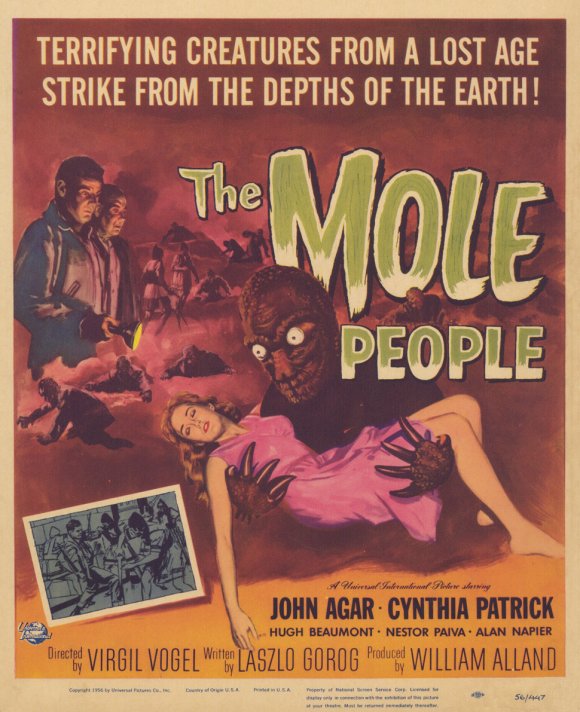 As misleading as lobby cards usually are. At no time does a Mole Person carry around the Marked Woman. Read on for explanations.
As misleading as lobby cards usually are. At no time does a Mole Person carry around the Marked Woman. Read on for explanations.
A party of archaeologists search for a temple of Ishtar in Sir Edmund Hillary’s stock footage of the Himalayas. The research grant that funded the trip did not include a GPS so they missed Babylon. Five in number they include the required local guide, the required Red Shirt, the required ethnic stereotype, the superfluous Beaver’s dad Ward, and a catatonic John Agar, doing what he does best, sleep walking to payday.
They come upon just such a temple as we saw in the Pergamon Museum in Berlin. Come to think of it, if in Berlin, why not in the Himalayas? During the ascent the local guide falls out of the picture and collects his check.
Next the Red Shirt carelessly falls through a crack in an earthquake. Agar, Ethnic Stereotype, and Ward descend to retrieve the Red Shirt’s Actors Equity card, and another quake seals them in. Doomed!
Mindful of his own career trajectory, Agar concludes that the only way to go it down. Down they go. Nestor Paiva is the ethnic in tow, a talented actor who is completely wasted in this role as the cowardly lion. We know he soon will join Guide and Red Shirt at the pay window.
They encounter stunt men in rubber suits — the Mole People (because Superman had copyrighted ‘Mole Men’ in 1951, this lot are ‘People.’) These encounters are very effective as the MPs rise up out of the sand piled on the sound studio floor. This was an inexpensive and effective method of staging.
They are rescued from the MPs by Babblers in funny hats from 3000 B.C. who have been living underground since then. Driven there by real estate prices up top. For these albinos theirs is the whole and only world. The scriptwriters betrays knowledge, often a firing offence in Hollywood, by having King Albino use sixty as a base number.
An effort is made to explain how they have survived. Mushrooms, which as any Hippie will say, have a lot to offer, goats, and fish. Minerals shine for light.
Behind King Albino is the High Priest who babbles a lot of nonsense that brought to mind sermons from the era, about how God loves only them, provides only for them, must be prayed to, and so on. Agar remains inert. He’s good at that.
The Babblers are suspicious of the surviving two, Agar and Ward. Nestor got Moled. But, well, maybe it is Ishtar’s will. Scripts work in mysterious ways.
Babblers live an orderly and clean life, but…. Yet, in short running time our heroes learn that the society exists on the slave labour of the black Mole People who are frequently beaten to death faire encourager les autres mining mushrooms. Moreover, the Babble-on population never exceeds 150. Never, because there are only so many mushrooms.
When there are more than 150, then the excess individuals are sacrificed to Ishatar.
Pause.
B movies were often accorded more latitude that A pictures, and that is apparent already in this one with its deprecation of religion, with the enslavement of blacks by the very white and cruel albinos.
We also get to see the sacrifice. Three young women calmly line up and pass through a door. Later guards remove three gruesomely charred corpses. It is the charred corpses that would never be seen in an A film. Young women dropping their robes as they serenely go to the oven, and that certainly got the attention of the fraternity brothers, is nothing new, but the crispy critters were. Is it another indictment of religious superstition?
These three had to go and they were chosen because they were marked! Yes they had some skin pigmentation. So those sacrificed were those of colour, Aryan though they seem, not so compared to the Babblers with their white pancake make-up.
By now Agar has his hand on a marked woman and she strokes his…ego.
Agar and Ward stop some cotton field overseers from beating three black Mole People to death, and free the beaten Moles. As the three freed MPs leave one returns and stares at Agar. This is communication of a sort.
Later when the Babblers decide there are not enough mushrooms for dinner they decide to toast Agar and Ward.
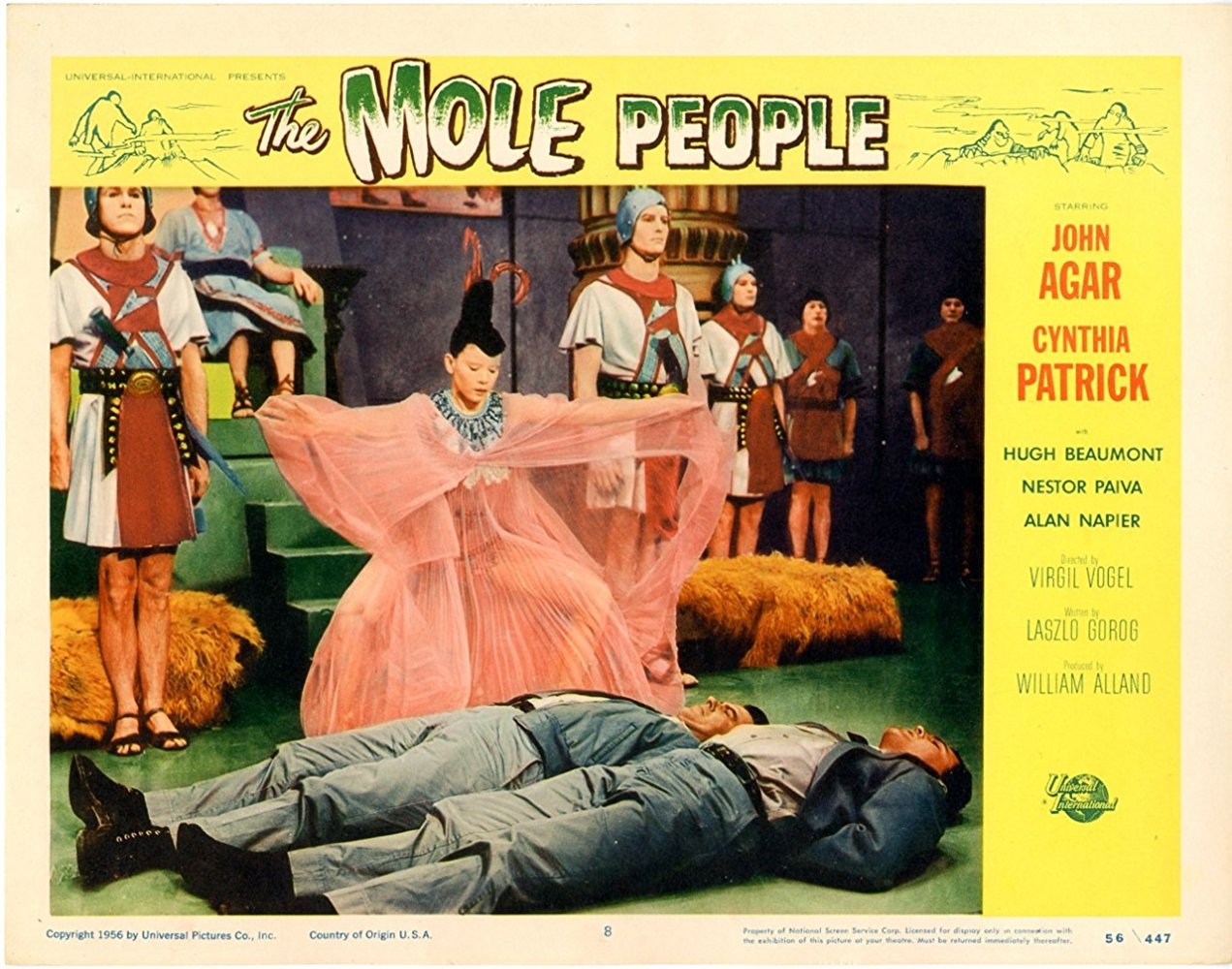 Agar at his best. Ward patiently waiting.
Agar at his best. Ward patiently waiting.
Then, thanks to the miracle of scriptwriting, the Mole People erupt out of the ground in revolt. Fisticuffs ensue. Marked Woman fails the test of opening the door by removing the bar, preferring to pound on it per the director’s instructions.
End of Babblers. The Mole People return to watching reruns of ‘Superman versus the Mole Men’ (1951), each time hoping it will turn out differently.
The oven behind the doors is sunlight through a fissure. This sunlight crisps albinos to a charred, barbecue black. Ward, Agar, and Marked Woman climb up the fissure to safety. But there is a surprise in the end, one that makes no sense. Spoiler! Another quake occurs and Marked Woman dies, leaving Agar without a date for his next binge.
The End.
Points of note include:
1.The scientists in Sy Fy are archeologists with neither magnets nor electricity
2. Established religion is superstition at best and deadly at worst.
3. Political power is short-sighted and self-serving.
4. A flashlight is essential to a spelunker and an exception to (1) above.
5. The whitest of whites are albinos and they enslave blacks.
6. They are also cruel to blacks.
7. They enjoy (5) and (6) above.
8. Mushrooms are best in beef stroganoff.
9. Human sacrifice requires disrobing to save on dry cleaning.
10. Sunlight without sufficient SPF produces crispy critters, turning albinos into black cinders.
11. Is it smart to sacrifice young women? The fraternity brothers cried, ‘No!’
12. This is not the only world.
13. The screen play by László Görög has some posers in it but the direction is petrified.
14. Despite the lobby card, the Mole People are the victims of the monstrous albinos.
These items help to overcome the nausea caused by the first five minutes in which Professor Frank C. Baxter (1896-1982), English, University of Southern California, lectures stunned viewers on speculations of underground worlds, without mentioning Pat Boone. Baxter was a television personality of the era meeting KPIs, Key Pontificating Irritants. He was public intellectual before that execrable concept was devised to licence ranters.
For the numerate, a few numbers from the fraternity brothers who were taking notes. There were 31 deaths (humans, Moles, and Babblers), while Prof Baxter made 38 hand gestures in five minutes. Of the 150 Babblers, twice sixty and a half, only 34 were seen at any one time. Only 18 Mole People were seen at once, and they bore 88 lashes.
‘Fog Island’ (15 February 1945)
IMDb meta-data: 1 hour and 12 minutes, 5.2 from 509 discerning cinemitizens.
After five years of porridge George Zucco is out for revenge! Shiver those timbers. While he was slammed up, someone went to Fog Island and killed Karma, George’s wife! That made for bad karma for him.
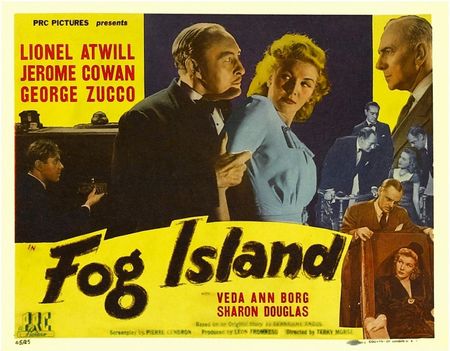
Since release he has holed up in a mansion with his step-daughter on Title Island to avoid a media feeding frenzy. To find the culprit(s) who framed him for embezzlement, he writes to them in a perfect Copperplate handwriting inviting them to visit him for a reunion. Who can resist Copperplate?
Otranto Island here they come! Meanwhile, George in a boiler suit does some home renovations for his forthcoming guests. He assumes their greed will bring them.
Greed? Here is where it gets foggy. George was innocent and framed by one or all of the invited associates, but each comes thinking to lay hands on the loot he allegedly but did not steal. See? ‘No,’ cried the fraternity brothers. ‘Did Georg Hegel write this,’ they asked? ‘Is it dialectic?’ Be that as it may, it gets no clearer.
In addition to the four associates, there is also a skulking butler, an accountant who rows to the island on his own to cooperate with George, and a beau for the step-daughter. The butler and the accountant know that George did not steal the dosh. See?
The four associates are: the turbaned head of a Psychic Research Centre, Lionel Atwill who is always a superb villain, Jerome Cowan who usually plays light, and Veda Ann Borg another treat. After the gang assembles for dinner, the men wearing tuxedos they packed for Otranto Island, George presents them each with a party favour, a key to one, a miniature skull to another, a baseball card, a pencil…. That got the fraternity brothers thinking, briefly.
This mansion, by the way, has all mod cons, a dudgeon, peep holes, secret passages, a moat, an oubliette, suits of armour, an organ, a sly butler as mentioned above, false doors, copies of ‘Crime and Punishment,’ dark corners, and a séance!
The guests do a lot of snooping around the place, and spying on each other. Among the ladies there is a very brief implication of lesbianism during a discussion of cleansing cream. The butler is the first to go and no one seems to notice.
About half way through, George’s contract ran out. Lionel is quick with a knife. Exit George. He fell at Lionel’s feet dead. Lionel, accustomed to such deaths from many previous films, does not bat an eye. Evidently he was the major culprit in the framing of George and the murder of Karma. If so, he should know there is no gelt to be had. So why is the dork there?
Though earlier Veda wanted to leave regardless of money, the script requires her to become mercenary, which she does with enthusiasm. Likewise the accountant, who knew George did not do it, joins the gang to find the ill gotten gains, which he knows do not exist. What a loser!
Somehow or other the party favours figure in the plot, but how, that is one of life’s mysteries. Veda seems the most normal, while Turban Woman’s fabricated pronouncements come true! Remember those home renovations. Even after his own death George has his revenge, leaving the daughter and beau to start afresh. The end.
This was one of Atwill’s last credits. Zucco, as always, dominates the camera.
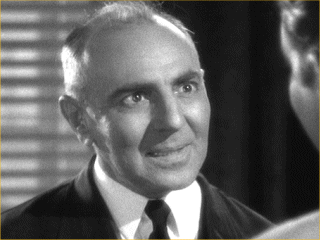 George Zucco
George Zucco
Cowan is better at light. The scripts is disjointed. Lionel asks the Psychic to perform a séance and as the others are seated, he walks away; unnoticed it seems, for some more snooping. Much of the film is so murky the sets could have been empty and probably were in this production from the Picture Releasing Corporation which was several strata below the bottom end of Poverty Row studios. In the gloom this viewer was often not sure who was whom and it was probably best that way.
As audiences saw this film news of the death toll on Iwo Jima would have begun to spread via seven thousand dreaded yellow ‘Regret to Inform you’ telegrams. Worse was to come at Okinawa.
‘Charade’ (1963)
Internet Movie Data base meta-date is run time 1 hour and 53 minutes, rated 8.0 by 55,708 cinemitizens.
Audrey finds herself the target of three thugs and Cary comes to her rescue. Stanley Donen, a master of musicals, out Hitchcocked Hitchcock in this confection. It is absolutely marvellous and eye candy from the opening credits.
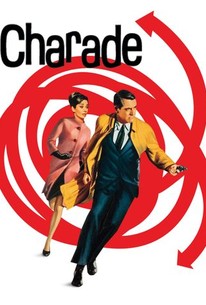
There is zing between Audrey and the twenty-six years older Cary. The villains are downright villainous and the diplomat is so oily that frequent hand washing is required.
The three thugs think she has the moolah for which her unloved husband was killed. There are rifts among them but no doubting their individual and collective willingness to do whatever it takes to get the money. In the brew is Cary, seemingly a bystander, but then it turns out he is has been involved all along. He has convinced the trio he is with them, while convincing Audrey he is not. Sometimes when all parties are in the same room. Is this man teflon or what.
All that romance is nice but where is the green stuff? Then the number of villains is reduced. Whoa! Who did that? Is there another party in this party? The fraternity brothers broke into a sweat at this point. Indeed, no one ever raises the obvious questions, who killed hubby? Well, the underused police inspector did but no one else seems to care.
The plot unfolds, and in so doing makes use of everything, including young Jean-Louis and that dental appointment. The pace is effortless. The direction crisp. The delivery of the lines is perfect enough to please any author. And the lines, including Audrey’s last, are gems.
I enjoyed seeing the American Express office in Paris where once I, too, along with Tyrone Power, collected mail. Niggles, I had a few. I bristled at the bland statement that the OSS was G2, Army Intelligence. No so. Nor was I at all sure that slipping 250,000 American dollars into 1944 France made any sense. Nor did the ease of infiltrating the US Embassy in Paris fit the Cold War milieu. The snapshots of the trio in uniform shows them in post war uniforms and haircuts. Hmm.
Hard though it is to believe, it did not win any Oscars. George Kennedy as the crazed Herman deserved one, along with the director. ‘Tom Jones’ and ‘Hud’ dominated the major awards that year. Granted ‘Hud’ had memorable dramatic performances from two veterans, Patricia Neal and Melvyn Douglas. But ‘Tom Jones’ came and went without a trace. Fun while it lasted but it did not last.
It has to be said that Funny Face carries the film, proven when one reviews the still photographs on the IMDb. She does comedy, romance, drama, determination, fear, alarm, conviction, love, all with elegance and grace. Her star eclipsed Cary’s in many a scene, so said the fraternity brothers.
Try this. Imagine a remake today with one of Hollywood’s drug addled egomaniac midgets in the lead, wearing a torn tee-shirt with a drippy nose. Audrey could be a self-centred talentless person famous for being famous on the way in and out of rehab with white spots on her cheeks. The writer will be a case of arrested development. This combination seems a sure recipe for success. All it needs is a lot of CGI and a soundtrack of train wrecks.
Instead of dirty money the quest can be….a vaccine to cure stupidity in climate deniers. No, that would not sell. Then the quest can be for… a lot of money to pay for making a trashy remake.
I hesitated to write it up, thinking there was nothing left to say, but the idea of remake and a check of Oscar winners for the year overcame that doubt. Moreover a look at some of the user reviews on IMDb brought up some truly ridiculous post-modern interpretations, which are beyond mockery, but there was the reek of PhD theses among them. A masochistic reader may wish to have a look.
